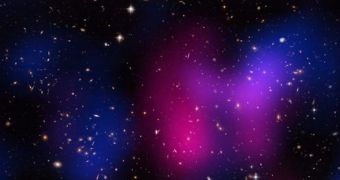A recent investigation revealed the existence of the Musket Ball Cluster, a space structure that revealed a surprising phenomenon – hydrogen gas within it is being separated from the colliding galaxies, as well as from dark matter.
What is interesting about this cluster is that it's a little more advanced down the evolutionary line than the Bullet Cluster. Scientists are basically trying to find at least one of these structures for each proposed stage of their evolution.
Additionally, the MBC is in fact a collision between two separate clusters, each containing a number of individual galaxies. When investigating the structure, experts focused their attention on the hot hydrogen gas in the cluster. The material shines very bright and hot in X-ray wavelengths.
In order to conduct this investigation, scientists used data from the NASA Chandra X-ray Observatory and Hubble Space Telescope, and from the Keck Telescope, the Kitt Peak Mayall Telescope and the Japanese Subaru Telescope, as well.
In the photo to the left, galaxies appear in white and yellow, as imaged by the Hubble. Data from Chandra, covering the distribution of hot hydrogen gas, are shown in red, while the distribution of mass in the cluster is shown in blue.
Like anywhere else in the Universe, dark matter accounts for most of the mass in the MBC as well. The image shows a clear dissociation between gas and dark matter within the colliding cluster, NASA reports.
“In the Musket Ball Cluster, the system is observed about 700 million years after the collision. Taking into account the uncertainties in the age estimate, the merger that has formed the Musket Ball Cluster is two to five times further along than in previously observed systems,” a statement from the agency says.
“Also, the relative speed of the two clusters that collided to form the Musket Ball cluster was lower than most of the other Bullet Cluster-like objects,” the document goes on to say.
“The special environment of galaxy clusters, including the effects of frequent collisions with other clusters or groups of galaxies and the presence of large amounts of hot, intergalactic gas, is likely to play an important role in the evolution of their member galaxies,” the press release concludes.

 14 DAY TRIAL //
14 DAY TRIAL //